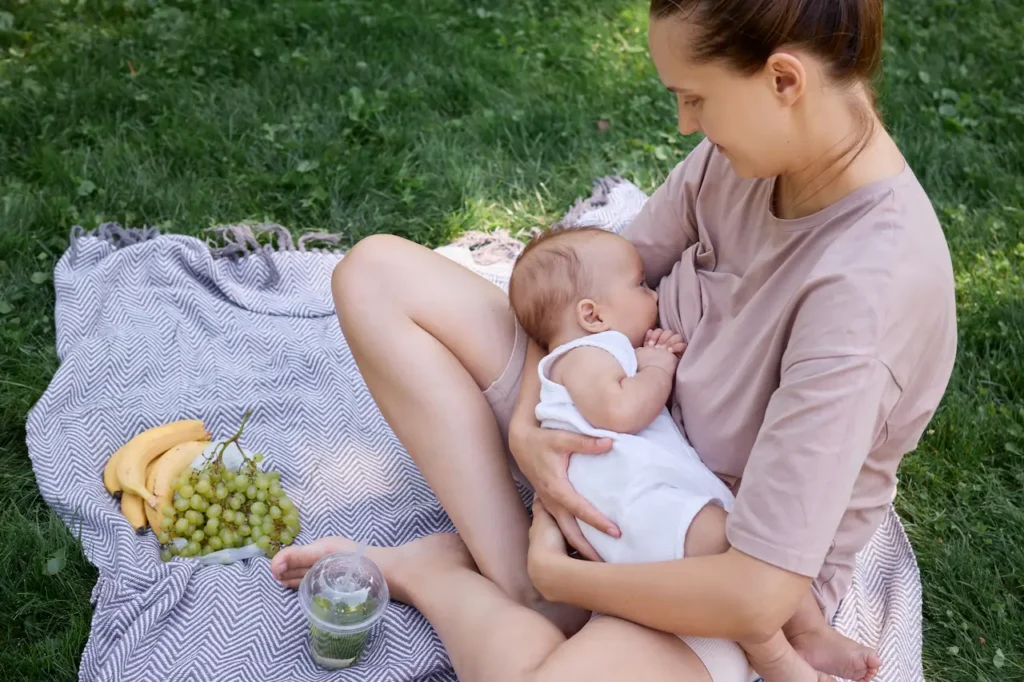How Mothers Fed Babies Before Formula?
Feeding Babies in a Formula-Free World: A Historical Perspective
How did mothers feed their babies in the days before formula? I was moved by the image of a woman’s struggle because we have become so used to formula feeding. What about mothers who couldn’t nurse their babies or didn’t access formula for various reasons?
When I delved into history, I discovered that many makeshift alternatives existed to breastmilk before the advent of formula. These methods may seem odd to us today, but reflect the creativity of parents during difficult times. It is fascinating to see how people used to feed their babies before the invention of formula.
Take a look back at how mothers have fed their infants over the centuries and see how society has evolved to improve this practice.
Wet Nursing: The Oldest and Most Common Practice

Wet Nursing is one of the oldest, most common alternatives to breast-feeding. This practice dates back to ancient civilizations and was still in use until the 20th Century. Wet nurses are women who breastfeed another woman’s baby, usually because the mother is unable to do so for various reasons. These include health complications, deaths during childbirth, or social pressures.
Wet nursing used to be an important part of infant care. This was common practice, especially among wealthy families that could afford to hire wet nurses to take care of their children while they took on other duties. Wet nurses could be hired as slaves or servants in some cases. The act of breastfeeding became a commodity and women were often forced to wet nurse under exploitative circumstances.
Wet nursing, despite its wide use, came with its problems. Wet nursing can be dangerous for babies because the milk supplied by the wet nurses is not as nutritious or rich as the mother’s breast milk. This practice wasn’t universally available, particularly for families with lower incomes who couldn’t afford a wet nurse.
Although the use of wet nurses decreased over time with the introduction of formula, they remained the primary method of infant feeding throughout the centuries.
Animal Milk: The Ancient Solution to Feeding Babies
Animal milk was used to replace breast milk before the advent of modern bottles. Ancient people used animals such as cows, goats, and sheep to provide milk for their infants. In archaeological digs, ancient ceramic vessels have been found. The vessels were used to store and feed animal milk to infants who were unable to breastfeed.
The use of animal-derived milk was not without its problems. One of the biggest problems was that hygiene standards were nonexistent and many ancient feeding vessels had been poorly sanitized. These vessels often put babies at risk of getting sick from drinking milk. Animal milk does not have the same nutritional value as human milk. This can cause malnutrition among infants.
Animal milk is not the best alternative. In many cases, animal milk was flavored with honey or sugar in order to make it more appealing for babies, with often harmful results.
Animal Horns: A Medieval Bottle?
In an odd twist of fate medieval parents used animal’s horns to make a feeding bottle for babies. They hollowed out the horns of animals such as cows and goats to allow their babies to drink directly from them. This may seem like a rudimentary and odd solution, but it shows the ingenuity of people at that time.
These animal horn bottles, like ancient clay vessels, posed serious health risks. At a time before sterilization, babies drank from horns that were unsterilized and unsanitary. These horns could have been full of bacteria and pathogens. It was considered better than not having any milk.
Wooden Vessels – Handcrafted and Carved Baby Bottles
Another solution that was used as a makeshift was to use carved wood vessels. In different cultures, wooden feeding bottles or bottles were used to feed babies. They would be filled with animal milk, and babies would drink it from the opening.
Wooden vessels are a better option for hygiene than horn bottles. However, they do not have the same ability to regulate flow or keep milk fresh. Wood can harbor bacteria, which could put the health of your baby at risk.
Dippy Bread and Cereal: Feeding Babies with Makeshift Porridge
Some families fed babies bread that was soaked in milk, water, or sugar water between the 16th century and 18th century. It was a common method of feeding, especially among parents who could not afford or access animal milk or a wet nursing mother. The bread was dipped into the liquid and then fed to babies in small quantities.
During this period, cooked cereal in bone broth also became a popular way to feed babies. These methods, while more accessible, were not nutritionally adequate. Infant mortality rates were high during this period, and poor feeding practices, such as dippy cereal or bread, also contributed to these tragic deaths.
Bread and cereals were introduced to a world that had little access to nutritious food. However, these practices are not safe. This practice left babies at risk of malnutrition and choking from poorly prepared food.
The Bubby Pot: A 1700s Baby Bottle
A device known as the Bubby Pot was created in the 1700s. It was made of pewter, silver, or other materials and looked like a small pot. The spout was covered with cloth, sponge, or other materials to serve as a treat for babies.
This was a clever solution for feeding babies without breast milk, but it wasn’t very effective. The spout design made it difficult to control the flow of milk, and, like older vessels, bacteria could grow inside. Bubby Pot is another example of an innovative idea that was well-intentioned but was not a good solution.
Spoon-feeding is Labor-intensive But Necessary.
In the 1800s some parents began to feed their babies milk with a spoon. This method involves feeding the baby directly with a teaspoon, usually using cow’s or milk diluted. Although it was labor-intensive and time-consuming, spoon-feeding was a common method of infant feeding before bottles were invented.
This method did not always work as well as mothers had hoped. Babies are more inclined to sucke than drink milk with a spoon. Spoon-feeding is also time-consuming and requires patience. This makes it less appealing for parents who are busy.

Sucking from Animals: An Unthinkable Practice
When human milk was not available, parents in desperate situations would allow their babies to drink directly from the teats of animals such as cows or goats. This method, while it may seem shocking to us today, was often used for practical reasons.
It was a practice that wasn’t generally accepted, and it was only used when there were no other options. Many people were horrified by the idea of babies sucking from animal teats, but it was an unfortunate reality in a time when infants’ lives were at stake.
Condensed Milk: The First Step Towards Formula
In 1853, Gale Borden an American chemist introduced Condensed Milk after adding sugar to evaporated dairy and canning. This was a breakthrough as it offered a stable and long-lasting alternative to milk. Condensed milk was not ideal for infants, because it was too sweet and lacking in nutrients.
Condensed milk had its own challenges, despite being widely sold. Condensed milk was very different from breastfeeding, and many babies that were fed it developed health problems. It was still a major milestone in the history and development of infant formulas.
The Rise of Baby Formula – From Chemists to Mainstream
In 1865, Justus Von Liebig a German chemist developed one of the first real baby formulas. The formula, which was made of milk, wheat, malt, and potassium bicarbonate flour, was among the first attempts to develop a suitable substitute for breast milk.
In the late 1800s there were many formulas on the market. Most of the early formulas, however, were high in sugar and fat, making them unsuitable to meet babies’ nutritional requirements. These formulas caused a rise in infant illnesses and deaths, but also marked the start of a new age in baby feeding.
Glass Bottles as the Origin of Baby Bottles
The need for feeding vessels increased as formula became more popular. In the mid-19th Century, bottles made of glass were used to feed infants. The first baby bottle was more advanced than the earlier alternatives. It featured cork nipples and ivory air inlets. The cork nipples allowed the milk to flow easier, but they still posed a health risk if not properly sanitized.
In the 20th century, formula feeding became common and bottles were refined. Rubber nipples and sterile feeding methods were eventually developed.
Rubber Nipple and the Modern Baby Bottle
rubber nibbles had been introduced by 1912 to make it easier for babies to be fed formula. Although the rubber nipples of early were unappealing in terms of taste and smell they were superior to alternatives made from cloth or rags. Rubber nipples were used to regulate milk flow and make formula feeding easier.
In the 1950s the rubber nipple was improved and formula feeding became widely accepted. Due to improvements in formula production and bottle designs, mothers can now confidently give their babies formula knowing it will nourish them safely.
Real-Life Stories of Families Coping
These methods might seem archaic but they demonstrate the lengths people would go to for their children. Families share their experiences with breastfeeding when it was not possible. One user reported that her grandmother diluted milk for her child. One user recalled that her grandmother wet-nursed her child in a hospital.
People like my ancestors used carnation or local milk diluted with sugar when formula was not available. In 1940s Ireland, a commenter described how her great-grandmother had no milk left for her fifth baby. The doctor then tested the milk of the local dairy herd and fed the baby the “thinnest”, sugar-sweetened milk. One user shared how her mother was raised in the 1950s next to twins who were fed diluted evaporated cow’s milk. These stories show the extremes that families would go to to keep their babies alive during a time when there were no options for proper nutrition or feeding. Amazing to see people’s resourcefulness in the face of adversity.

Conclusion:
It’s obvious that, when we look back at these historic methods of feeding babies, we’ve made a lot of progress. Humanity has always found ways to feed the most vulnerable in society. From animal horns to wet nurse formulas to rudimentary forms of nutrition, there are many examples. We are lucky to have formulas designed by scientists that give babies the nutrients they require to grow healthy and strong.
The evolution of infant feeding is a reflection of the resourcefulness and resilience of previous generations as well as of the critical role modern science plays in improving infant care. We are grateful for all the technological advances that make feeding babies safer, easier, and more effective.



